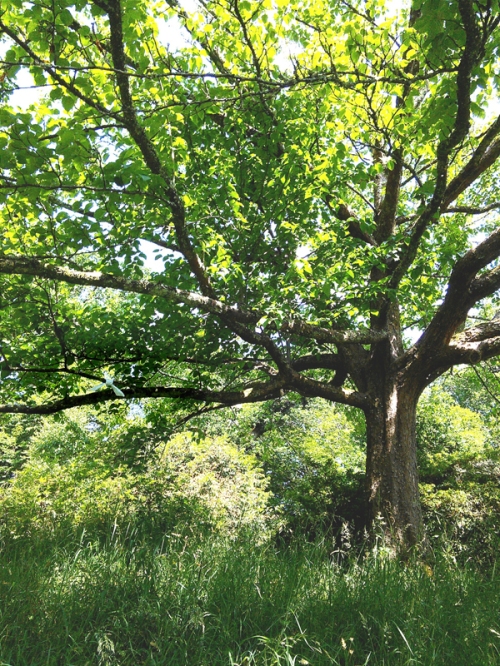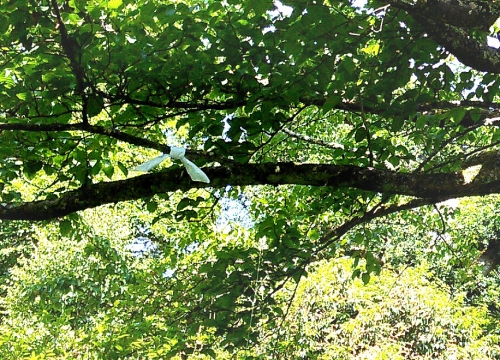
photo by Karen Christopher
After our performance as part of
Open Schoolbook we gave a short talk about our experience of the workshop over the three years.
Karen spoke in three sections followed by three students each time.
The Dove, the Ghost, the Handkerchief Tree
Year One:
Tom & Alfie, Gionna & Katerina, Billie & Kalila, Matthew & Henrik, Harriet & JoJo, Ben & Tom, Chloe & Adrian
I thought of landscape as a memory container, landscape as a deeper anchor for being, and the object of an enduring love.
I thought about what the end of Dartington might mean to a group of students who would spend 3 years there and then leave for other parts. How or why does it matter to them?
How do I feel that I can never revisit the house I think of as my childhood home? A home I lived in for only 3 years @ ages 10, 11 & 12 which nonetheless bears the weight of the idea of my childhood. Knowing it has been demolished feels different from when I imagined it still existed. It remains a place of solace. As a child, the kind of attention and time I spent focussed on it marked it within me, ground out a foundation from which spring ideas about my own place in the world. I fixed on the idea of solace, of finding ways for those first year students I began working with 3 years ago (in the hexagon, in studio 33 and in the abandoned grounds of the long-empty Dartington Hall School) to imprint the contours both interior and exterior, the landscape of Dartington, the essence of its placeness.
We wanted to make of it a container. We held bits of it in our hands and we allowed those bits to determine our partnerships.

photo by Benjamin Thompson
Tom shouted “Falmouth you stepmother!” Kalila brought something inappropriate to the meadow. I said: discover or invent a history for a plant in the garden, memorize a path. We named or re-named favorite spots. We sang farewell to the land, buildings, place, to the feeling of being there.
We waved our handkerchiefs. We surrendered to goodbye.
Karen Christopher

photo by Ben Thompson
(yet to come)
Kalila Storey
Remembering when. Getting closer, stepping forward, stepping back, stepping forward. Getting to a point where I could have chosen to go up some stairs, over a bridge, or carry on with the path I was already on, And at the time only really considering the stairs or the bridge, as if I had forgotten that I had a third option. Breathing heavier, breathing lighter. Counting 61 steps. Attempting to lay a potentially ephemeral foundation whilst wondering how to look back.
Laura Doherty
(yet to come)
Josephine McCourt


Year Two:
Rachel & Matthew, Harriet & Jess, Sophie & Laura, Ben & Gionna & Kalila, Adrian & Tate, JoJo
To forget is human. Perhaps the essence of being human is not that we remember but what we forget.
We devised disappearing acts. We demonstrated laws: of nature, of physics, of performance, of society, of art, of the state. We contemplated what is affected by water, what is worn down over time. We contemplated the idea of giving ones life for one last glance back at a beloved home. We turned into rivers of salt. We regarded the horizon. We demonstrated the last gesture we would perform at Dartington and the first we would perform at Falmouth. We designed a walk. We memorized it.
We envisioned dear old Dartington alongside JoJo’s Nan. We adopted the postures of rock stars to prove we could take it. We could take all the salt water we had to. We stood there and wavered.
Karen Christopher

photo by Karen Christopher
This is an invitation to be yourself. Whoever that might be. It’s an invitation to show somebody a side they never saw of you before, whether that is real or imagined. Whether based on fact or fiction, be yourself. Or at least pretend to be.
Rachel Gibbens
When I was 11 I found myself to be in the final year that would go through my primary school. The school would relocate to a new site, the other children would move with it, but, as members of year 6, we would have to move on. On the last day my classmates and I stood on the school stage, and we cried. We thought that something would be forever lost.
On the last day of the last Dartington festival I found myself on stage again, and yes, tears were shed, but mass hysteria did not set in this time. This time hugs were exchanged, hugs of relief, hugs of grief and hugs which simply said, I’m here with you, in a way that words could not.
Each year this project has come like those much needed hugs. It has taken care of us, it has tended to our wounds, and somehow, it manages to soothe our constantly breaking hearts.
Matthew Smallwood
(yet to come)
Adrian Spring

photo by Lucy Cash
Year Three:
Alfie, Gionna & Harriet; Kalila, Rachel & Laura; JoJo, Matthew & Adrian
We walked in silence for 90 minutes. I neglected to stop. So long leading the march forward, so dogged, I couldn’t hear the closing bell. We found the grotto, we read the stone. We regarded our surroundings. the scales fell from our eyes. A meadow. It used to be a meadow. We drew a map of this moment (again). We found that each question had many answers. I prepared with a focus on the creative act of composing performance directives.
A performance directive is a written inscription, composed or constructed from gathered material. One of the particularities of a directive is that it is a suggestion towards a possible future or a possible performance. A performance directive is not written in anticipation of a right or wrong answer. Rather than telling how something should be done, it is an invitation. An invitation to be translated according to and depending on the person responding.
A performance directive is a creative act. It is an invitation to respond with care, to lift from ‘casual’ to ‘eventfulness’. You may want to consider it as a system of limitations that supports proliferation.
Notice there is permissiveness inherent in every directive.
Take a moment to remember a successful directive you’ve been given in the past or maybe you need to remember when you made something you loved and think back to what the initial spark was, what was the first act that lead to the discoveries that became something you were happy to work on?
Make notes on what qualities a successful directive should have.
Write a directive to bring in to the first day of the third section of The Dove, the Ghost, the Handkerchief Tree. Your directive should address three elements that make up different aspects of material to be generated: duration, speed, rhythm, content (subject), body part, materials, color, text, etc.
A performance directive is:
a form of future building
a runway for take-off
There’s a load of gravel and we are taking off our shoes.
Karen Christopher

photo by Lucy Cash
The first time I went to Dartington I fell in love, I wanted to run away to be part of what was there. Falmouth was, for me, tainted by the loss of that. I wasn’t in love with this place and I felt as if I was watching the death of someone close to me. Even as I was saying goodbye I was resisting that I had to. I’m still not in love with Falmouth, maybe I never will be, but I’m choosing to take this opportunity to help others find here what I found in Dartington.
Gionna Rose
(yet to come)
Alfred Heffer
(yet to come)
Harriet Couzens

photo by Lucy Cash

























